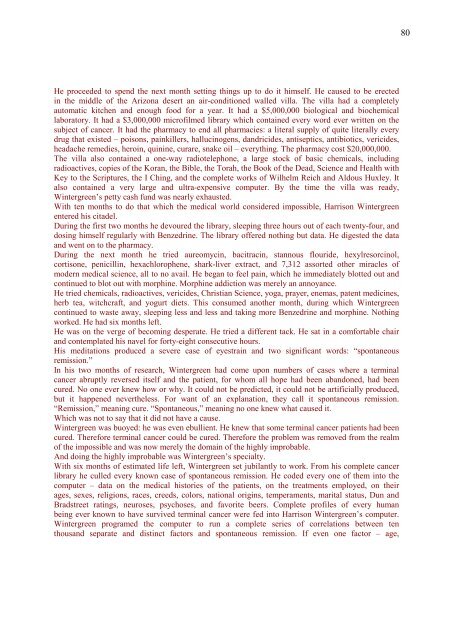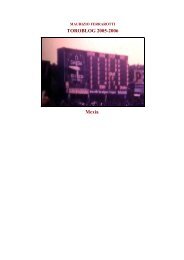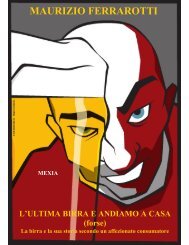Torino è la mia città 2008-2009: Figomania - Ferrarotti, Maurizio
Torino è la mia città 2008-2009: Figomania - Ferrarotti, Maurizio
Torino è la mia città 2008-2009: Figomania - Ferrarotti, Maurizio
Create successful ePaper yourself
Turn your PDF publications into a flip-book with our unique Google optimized e-Paper software.
He proceeded to spend the next month setting things up to do it himself. He caused to be erected<br />
in the middle of the Arizona desert an air-conditioned walled vil<strong>la</strong>. The vil<strong>la</strong> had a completely<br />
automatic kitchen and enough food for a year. It had a $5,000,000 biological and biochemical<br />
<strong>la</strong>boratory. It had a $3,000,000 microfilmed library which contained every word ever written on the<br />
subject of cancer. It had the pharmacy to end all pharmacies: a literal supply of quite literally every<br />
drug that existed – poisons, painkillers, hallucinogens, dandricides, antiseptics, antibiotics, vericides,<br />
headache remedies, heroin, quinine, curare, snake oil – everything. The pharmacy cost $20,000,000.<br />
The vil<strong>la</strong> also contained a one-way radiotelephone, a <strong>la</strong>rge stock of basic chemicals, including<br />
radioactives, copies of the Koran, the Bible, the Torah, the Book of the Dead, Science and Health with<br />
Key to the Scriptures, the I Ching, and the complete works of Wilhelm Reich and Aldous Huxley. It<br />
also contained a very <strong>la</strong>rge and ultra-expensive computer. By the time the vil<strong>la</strong> was ready,<br />
Wintergreen’s petty cash fund was nearly exhausted.<br />
With ten months to do that which the medical world considered impossible, Harrison Wintergreen<br />
entered his citadel.<br />
During the first two months he devoured the library, sleeping three hours out of each twenty-four, and<br />
dosing himself regu<strong>la</strong>rly with Benzedrine. The library offered nothing but data. He digested the data<br />
and went on to the pharmacy.<br />
During the next month he tried aureomycin, bacitracin, stannous flouride, hexylresorcinol,<br />
cortisone, penicillin, hexachlorophene, shark-liver extract, and 7,312 assorted other miracles of<br />
modern medical science, all to no avail. He began to feel pain, which he immediately blotted out and<br />
continued to blot out with morphine. Morphine addiction was merely an annoyance.<br />
He tried chemicals, radioactives, vericides, Christian Science, yoga, prayer, enemas, patent medicines,<br />
herb tea, witchcraft, and yogurt diets. This consumed another month, during which Wintergreen<br />
continued to waste away, sleeping less and less and taking more Benzedrine and morphine. Nothing<br />
worked. He had six months left.<br />
He was on the verge of becoming desperate. He tried a different tack. He sat in a comfortable chair<br />
and contemp<strong>la</strong>ted his navel for forty-eight consecutive hours.<br />
His meditations produced a severe case of eyestrain and two significant words: “spontaneous<br />
remission.”<br />
In his two months of research, Wintergreen had come upon numbers of cases where a terminal<br />
cancer abruptly reversed itself and the patient, for whom all hope had been abandoned, had been<br />
cured. No one ever knew how or why. It could not be predicted, it could not be artificially produced,<br />
but it happened nevertheless. For want of an exp<strong>la</strong>nation, they call it spontaneous remission.<br />
“Remission,” meaning cure. “Spontaneous,” meaning no one knew what caused it.<br />
Which was not to say that it did not have a cause.<br />
Wintergreen was buoyed: he was even ebullient. He knew that some terminal cancer patients had been<br />
cured. Therefore terminal cancer could be cured. Therefore the problem was removed from the realm<br />
of the impossible and was now merely the domain of the highly improbable.<br />
And doing the highly improbable was Wintergreen’s specialty.<br />
With six months of estimated life left, Wintergreen set jubi<strong>la</strong>ntly to work. From his complete cancer<br />
library he culled every known case of spontaneous remission. He coded every one of them into the<br />
computer – data on the medical histories of the patients, on the treatments employed, on their<br />
ages, sexes, religions, races, creeds, colors, national origins, temperaments, marital status, Dun and<br />
Bradstreet ratings, neuroses, psychoses, and favorite beers. Complete profiles of every human<br />
being ever known to have survived terminal cancer were fed into Harrison Wintergreen’s computer.<br />
Wintergreen programed the computer to run a complete series of corre<strong>la</strong>tions between ten<br />
thousand separate and distinct factors and spontaneous remission. If even one factor – age,<br />
80







